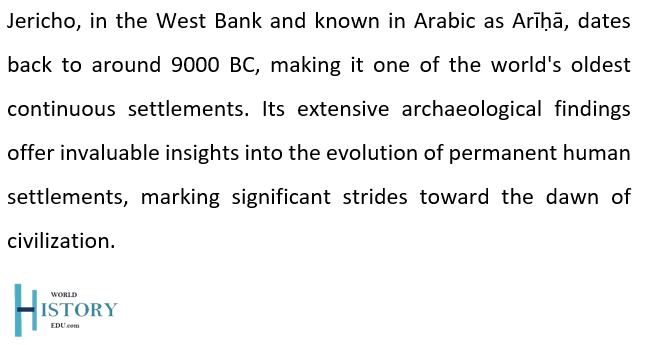The Ancient City of Jericho: History and Major Facts
Jericho, one of the world’s oldest inhabited cities, holds a significant place in the annals of human history. Its antiquity, coupled with its notable mentions in religious texts and its strategic position, makes it a vital archaeological and historical site.
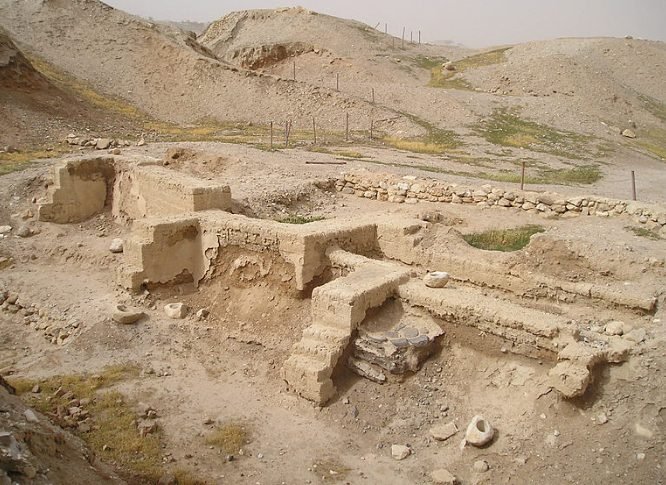
The significance of Jericho lies not just in its biblical connections but in its testament to early urbanization, defense strategies, and cultural evolution in the ancient Near East. The city represents thousands of years of human history, and its layers tell stories of innovation, conflict, survival, and adaptation. Image: Dwelling foundations unearthed at Tell es-Sultan in Jericho
Here is everything that you need to know about the ancient city of Jericho, a city generally accepted by scholars as one of the oldest in human history.
Geographical Significance
Located in the Jordan Valley, just north of the Dead Sea and west of the Jordan River, Jericho boasts an oasis-like environment due to a number of natural springs, particularly the Spring of Elisha. Its strategic location along ancient trade routes made it a key city in antiquity.
Historical Timeline:
- Pre-Pottery Neolithic (circa 10,000 – 8,000 BC): The first permanent settlement at Jericho dates back to this period, marking it as one of the earliest towns. Monumental structures like the Tower of Jericho, possibly one of the earliest examples of communal architecture, were constructed during this time.
- Bronze Age (circa 3,300 – 1,200 BC): Jericho evolved into a fortified city with walls, marking a significant technological advance. These walls were later mentioned in the biblical story of the Battle of Jericho.
- Iron Age (circa 1,200 – 332 BC): Following a period of decline, Jericho regained importance under the rule of various empires, including the Egyptians, Hittites, and Assyrians.
Religious Significance
For many, Jericho is synonymous with the biblical story found in the Book of Joshua. According to the Hebrew Bible, the Israelites, led by Joshua, circled the walled city for seven days, and on the seventh day, with the priests sounding trumpets, the walls of Jericho fell, allowing the Israelites to capture the city.
Archaeological Revelations
Archaeological digs at Jericho have unveiled a wealth of information:
- The Wall and the Tower: Kathleen Kenyon’s excavations in the 1950s revealed the remains of a massive wall and a tower, suggesting a well-fortified city. The wall was made of mud bricks and was at least 5 feet thick. The tower, nearly 8 meters in height, dates back to the Pre-Pottery Neolithic.
- Tombs and Burial Customs: Numerous tombs from different periods have been unearthed, indicating evolving burial practices. Some of the earliest graves contain skulls that were plastered to recreate facial features, possibly reflecting ancestor worship or a form of proto-portraiture.
- Ancient Agriculture: Archaeological evidence points towards cultivation of cereals like barley and wheat. The perennial springs provided consistent water, making agriculture possible despite the surrounding desert.
Challenges to Biblical Narratives
While Jericho’s walls are well-documented archaeologically, their date and the nature of their destruction have become sources of debate, especially concerning their relation to the biblical account. Kathleen Kenyon argued that the walls were destroyed around 1550 BC, well before the Israelites would have arrived. However, other archaeologists, such as Bryant Wood, argue for a later date that aligns more closely with the biblical timeline.
Roman and Byzantine Periods
Following its conquest by the Roman General Pompey in 63 BC, Jericho underwent significant development. The Romans and their successors, the Byzantines, built palaces, aqueducts, and fortifications in and around Jericho.
Islamic Era to Modern Day
After the Islamic conquest in the 7th century AD, Jericho’s significance waned. It became a small village during the Mamluk and Ottoman periods. The modern city began to develop in the late 19th and early 20th centuries, especially during the British Mandate in Palestine. Today, it’s a Palestinian city in the West Bank known for its rich history and archaeological sites.
Conclusion
Jericho’s significance extends beyond its biblical associations. As one of the earliest and continuously inhabited cities, it provides a lens into the evolution of human civilization over millennia. From its ancient walls and tower to its place in religious narratives and its continued existence today, Jericho remains a testament to humanity’s enduring spirit and ingenuity.
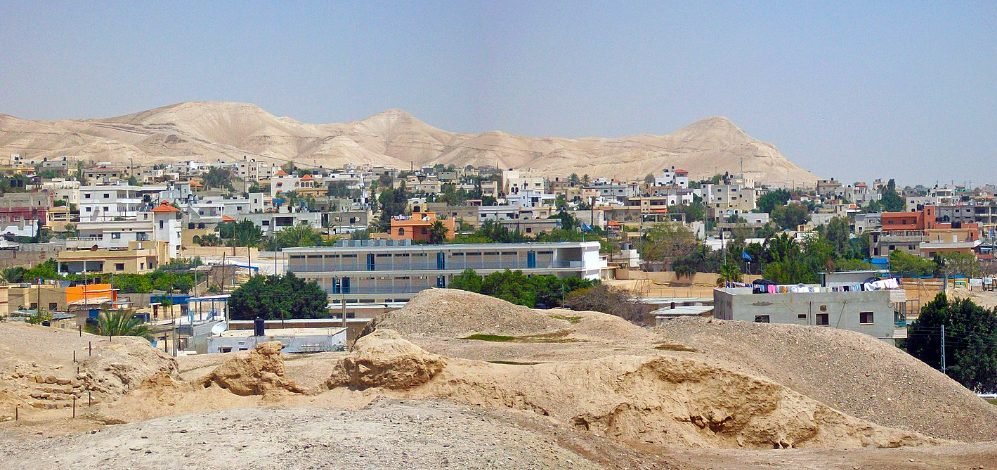
View of Jericho from Tell es-Sultan
Frequently asked questions
Jericho, often associated with the biblical tale in the Book of Joshua where its walls collapsed after the Israelites circled it seven times, has a history predating this event. Before the Israelites’ arrival, Jericho was already ancient, standing as one of humanity’s earliest cities. Its existence marked a pivotal shift from nomadic hunter-gatherer lifestyles to settled civilizations.
What does the name mean?
Jericho’s Hebrew name, Yeriẖo, likely stems from the Canaanite word “rēḥ” meaning “fragrant.” Some believe it’s related to “moon” (Yaraḥ) or the lunar deity Yarikh. The Arabic name, ʼArīḥā, meaning “fragrant”, originates from Canaanite Reaẖ.
Where is the location of the archeological site of Jericho?
The archaeological site of Jericho is located in the West Bank, near the Jordan River. It’s situated north of the Dead Sea and approximately 10 kilometers (around 6 miles) northwest of the modern city of Jericho. Today, this area is known as Tell es-Sultan, which is an ancient mound or “tell” that has accumulated from centuries of human habitation. Over the years, numerous excavations at Tell es-Sultan have revealed layers of history, providing insights into the many civilizations that once occupied this ancient city.
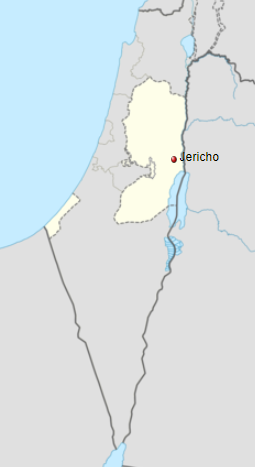
Location of Jericho within Palestine
What are some of the major excavations of Jericho that have taken place?
The ancient city of Jericho has been the focus of numerous archaeological excavations over the years. These excavations have revealed fascinating insights into early urban development, fortification systems, and the various inhabitants who lived in the region across different eras.
Some key findings and aspects of these excavations include:
- The site began to draw attention in the 19th century. British archeologist and officer in the Royal Engineers Charles Warren (1840 – 1927) conducted a preliminary survey in 1868. Later, German archaeologist Carl Watzinger and theologian Ernst Sellin conducted excavations between 1907-1909, unearthing a series of walls and a massive tower.
- British archaeologist Kathleen Kenyon is perhaps the most famous excavator of Jericho. Between 1952-1958, using the stratigraphic methodology, she identified many distinct layers of occupation, providing a clear sequence of the city’s history. Her work confirmed the existence of a fortified Neolithic settlement, predating the Bronze Age city by several millennia.
- One of the most striking findings is the evidence of a Pre-Pottery Neolithic settlement dating around 8000 BC. This period saw the construction of the famous stone tower, which is considered one of the earliest known fortification systems.
- The Bronze Age city, particularly in the Early and Middle Bronze Age, was a fortified urban center. Massive walls, some of which may be referenced in the biblical story of the Battle of Jericho, were found from this period.
- There are layers showing evidence of destruction and burning, but there has been debate among archaeologists about correlating this with the biblical account of the Israelite conquest. Kenyon, for instance, believed that the destruction layers were earlier than the proposed timeline for Joshua’s conquest.
- Surrounding the site, numerous tombs from various periods have been found. These tombs contain pottery, jewelry, and other artifacts that provide valuable insights into the burial customs, trade, and daily life of Jericho’s inhabitants over the ages.
- Beyond the Bronze Age, excavations have revealed evidence of Iron Age settlements, possibly linked to the Israelites. The site also has remnants from the Hellenistic, Roman, Byzantine, and Islamic periods, showcasing the long and varied history of occupation at the site.
- After Kenyon’s work, the site was excavated by a team from the University of Rome between 1997 and 2000, and there have been several other projects since, each providing more layers of understanding to this ancient city.
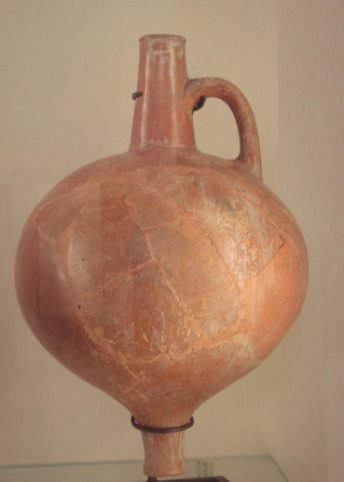
Image: Red terracotta jar, Ancient Bronze period 3500–2000 BC, Tell es-Sultan, ancient Jericho, Tomb A IV. Louvre Museum AO 15611.
Is Jericho the oldest known city in human history?
Jericho is often cited as one of the oldest continuously inhabited cities in the world, with evidence of settlement dating back to around 9,000 BC or earlier. The archaeological remains of a tower and wall from the Pre-Pottery Neolithic age at Jericho are among the world’s earliest known fortifications.
However, while Jericho is unquestionably ancient and significant, it’s not definitively the “oldest known city” in human history. The title of the “oldest city” can be somewhat subjective and depends on the specific criteria being used (e.g., continuous habitation, urban structure, size).
There are other ancient sites in the Near East, such as Göbekli Tepe in modern-day Turkey, which dates back to around 10,000 BC or earlier. However, Göbekli Tepe is more of a temple complex than a city. There’s also Çatalhöyük, also in Turkey, which dates to around 7,500 BC and exhibits many characteristics of early urban life.
In Mesopotamia, sites like Eridu and Uruk have been inhabited for thousands of years and played significant roles in the development of urban civilization.
READ ALSO: Most Famous Ancient Mesopotamian Cities
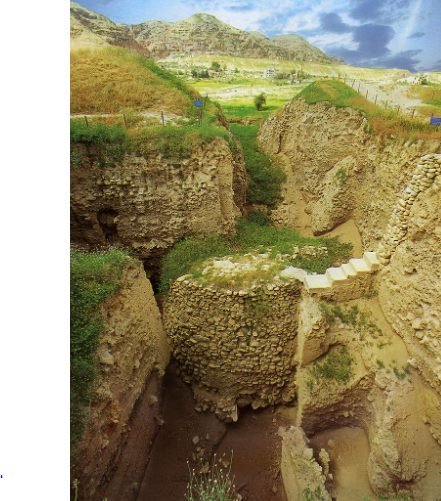
While Jericho is one of the world’s oldest known continuously inhabited sites, there are other ancient settlements that also lay claim to the title of “oldest city.” The determination often hinges on how one defines a “city” and what criteria are prioritized. Image: The 8000 BC Tower of Jericho at Tell es-Sultan
What was the culture like of the early inhabitants of the city of Jericho?
The early inhabitants of the city of Jericho, one of the oldest inhabited cities in the world, lived through various cultural and technological changes.
Here are some highlights of their culture:
- Settlement and Architecture: Before the advent of agriculture, the Natufian culture, which had semi-sedentary traits, lived in Jericho. The subsequent Pre-Pottery Neolithic A (PPNA) period saw the construction of circular houses made of mud-brick walls with flat roofs. As the settlement grew, defensive structures, like walls and towers, were built.
- Subsistence: Initially, the inhabitants relied heavily on hunting and gathering. They exploited wild cereals and eventually domesticated emmer wheat, barley, and pulses. Over time, they began domesticating animals, most notably sheep, signifying a move towards a sedentary agricultural lifestyle.
- Religion and Burial Practices: The spiritual beliefs of these early inhabitants are evident from their unique burial practices. They had a tradition of plastering the skulls of the dead and placing shells in the eye sockets. This could suggest ancestor veneration or a belief in the afterlife. Bodies were often buried under house floors or within the settlement, signifying a close bond between the living and the dead.
- Arts and Crafts: The plastered skulls indicate an early form of art. Additionally, the inhabitants used stone tools, demonstrating a growing mastery in tool production. As the community evolved, more advanced tools, like quern stones for grinding and spindle whorls for spinning fibers, were developed.
- Social Organization: The construction of walls and towers suggests some form of communal organization and cooperation. The presence of these defensive structures indicates either external threats or a need for flood control.
- Trade and Interaction: Given Jericho’s location and the variety of tools and materials found there, it’s likely that its inhabitants engaged in trade with neighboring regions.
How did the culture and landscape of Jericho evolve over the centuries?
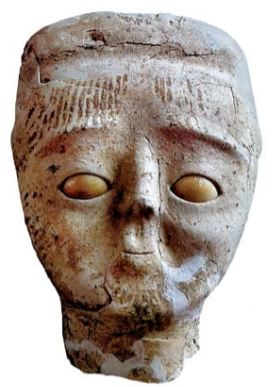
In addition to being a big contender for the oldest city in the world, Jericho is also the city with the oldest known protective wall. Image: Head of an ancestor statue, Jericho, from c. 9000 years ago, among the oldest representations of a human face ever found. Rockefeller Archeological Museum, Jerusalem
The Natufian culture, prevalent in the Levant approximately 15,000 to 11,500 years ago, deviated from the traditional hunter-gatherer nomadic lifestyle. Notably, they laid the foundation for the city of Jericho by establishing semi-sedentary settlements even before agriculture’s onset. Their resilience was tested during the Younger Dryas, a harsh glacial period.
However, the freshwater springs at Jericho provided respite. When the climate became warmer post-9600 BC, the site transformed from a temporary refuge to a permanent settlement, with enduring structures by 9500 BC.
This era, from 9,500 to 6,500 BC, is termed Pre-Pottery Neolithic (PPN) in Jericho’s archaeological record, differentiated into PPNA and PPNB. Surprisingly, pottery was absent, and tools were crafted primarily from wood and stone. Life during this time was largely reliant on hunting and gathering, but the advent of agriculture started taking shape with domesticated grains like emmer wheat and barley.
Dwellings were circular, constructed from clay and straw. The Sultanian settlement (8350-7360 BC) expanded to about 420,000 square feet, protected by a 12-foot wall and a remarkable 28-foot tower, believed to guard against floods rather than human threats. The settlement’s population remains uncertain, varying from 300 to 3000.
The site saw a temporary abandonment before the Pre-Pottery Neolithic B era (7220-5840 BC), which witnessed technological advancements, diversified agriculture, and attempts at animal domestication. Spiritual practices, resembling those at Çatalhöyük, emerged, where plastered skulls adorned homes, believed to be the spiritual essence. Concurrently, innovations in stone tool-making showcased evolving craftsmanship during this period.
From around 4500 BC to the late Bronze Age (around 1410 BC), Jericho witnessed a series of settlements, reaching its peak size and population in the mid-3rd millennium BC. Featuring robust walls and a grand palace, it was a significant Canaanite city.
Contrary to the Book of Joshua, which narrates the Israelites’ destruction of Jericho, archaeological evidence suggests the city’s walls collapsed around 1573 BC, likely due to an Egyptian campaign against the Hyksos. By Joshua’s purported time (13th century BC), Jericho was deserted.
After its Bronze Age abandonment, the city was rebuilt during the Iron Age but later destroyed by the Babylonians in the 6th century BC.
Under Persian rule, it was revitalized, later becoming Alexander the Great’s estate and then part of the Seleucid Empire. The Hasmoneans and then the Romans, with King Herod enhancing its grandeur, subsequently controlled it.
Today, Jericho, with its 12,000-year history, is a significant Palestinian town in the West Bank.

It’s important to note that our understanding of the early inhabitants of Jericho is based on archaeological evidence, which provides a partial and evolving picture of their culture. New discoveries can lead to revised interpretations of their way of life.
What makes the Walls of Jericho so significant?
The ancient Neolithic settlement of Jericho was encircled by massive stone walls, constructed around 8000 BC. Standing at least 13 feet high, with a 28-foot watchtower, these walls protected its inhabitants and vital water sources from threats. Representing early military technology, these fortifications are the earliest known structures built specifically for defense.
Located at Tall al-Sulṭān (Tell es-Sultan), this archaeological marvel was recognized as a UNESCO World Heritage site in 2023.
